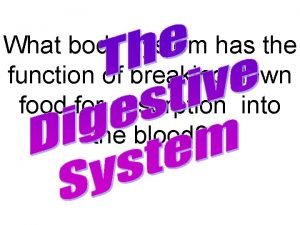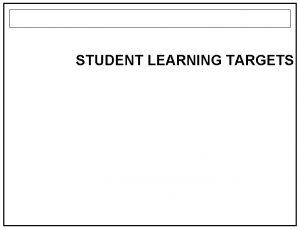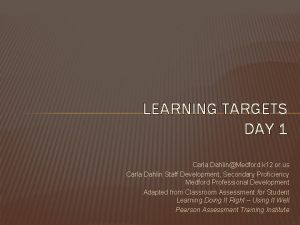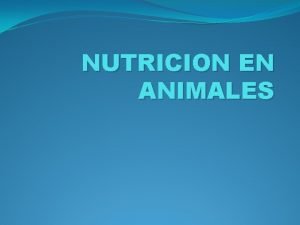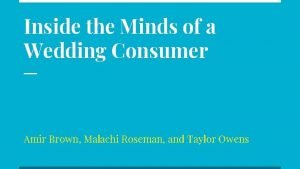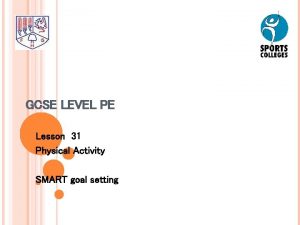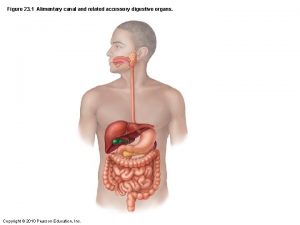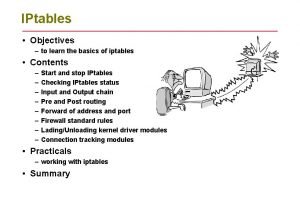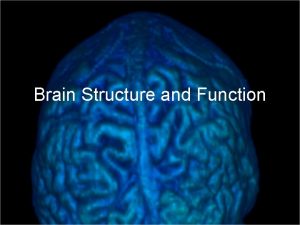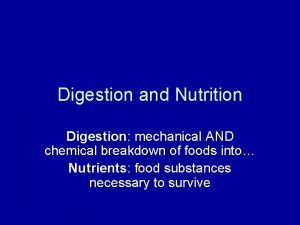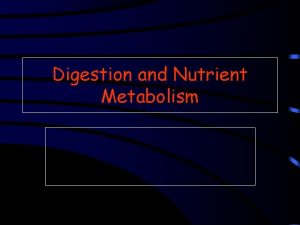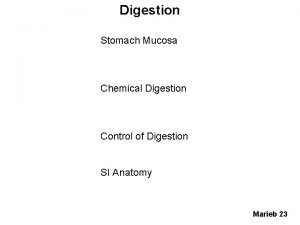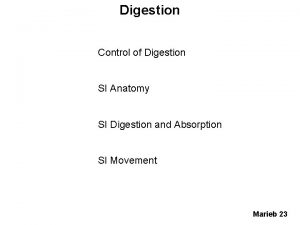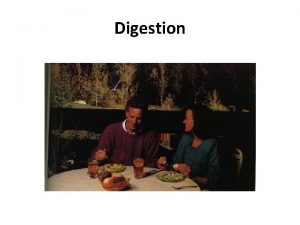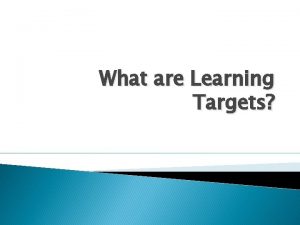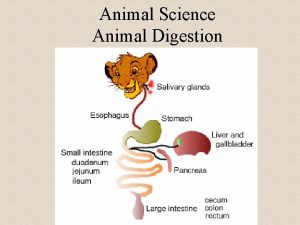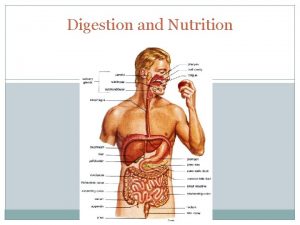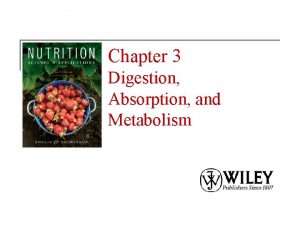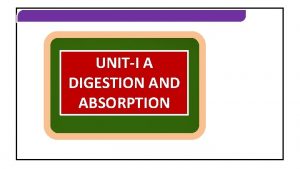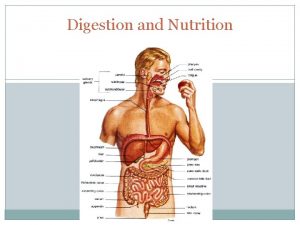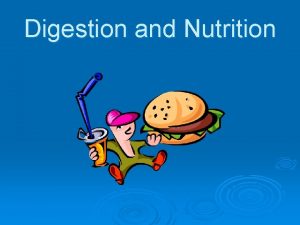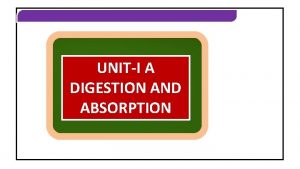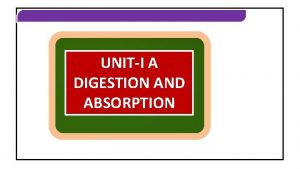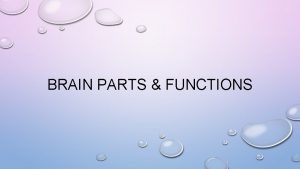Animal Digestion Structures and Functions Learning Targets I














































- Slides: 46

Animal Digestion Structures and Functions

Learning Targets I can identify the structures and functions of the digestive system.

Digestive Systems • Digestion is the process of breaking down feed into simple substances that can be absorbed by the body. • Absorption is taking the digested parts of the feed into the bloodstream.

Digestive Systems • The digestive system consists of the parts of the body involved in chewing and digesting feed. ▫ This system also moves the digested feed through the animal’s body and absorbs the products of digestion.

Digestive Systems • Different species of animals are better able to digest certain types of feeds better than others. • This difference occurs due to the various types of digestive systems found in animals.

Digestive Systems • There are four basic types of digestive systems: ▫ ▫ Monogastric (simple) Avian Ruminants (polygastric) Pseudo-ruminants.

Monogastric • A monogastric digestive system has a simple stomach. ▫ The stomach is a muscular organ that stores ingested feed and moves it into the small intestine. ▫ The stomach secretes acid. �The acid results in a low p. H of 1. 5 to 2. 5. The low p. H destroys most bacteria and begins to break down the feed materials.

Monogastric • Animals with this type of digestive system are better adapted to the use of concentrated feeds, such as grains, than the use of large quantities of roughages. • Examples of monogastric animals are dogs, cats, swine and humans.


Avian • The avian digestive system is found in poultry. ▫ This system differs greatly from any other type. ▫ Since birds have no teeth, there is no chewing. ▫ The esophagus empties directly into the crop. ▫ The crop is where the food is stored and soaked. ▫ From the crop the food makes it way to the gizzard.

Avian • The gizzard is a very muscular organ, which normally contains stones or grit which functions like teeth to grind the food. • Digestion in the avian system is very rapid.


Ruminant • The polygastric or ruminant digestive system has a large stomach divided into compartments. • The polygastric system is designed for food to be ingested, eructated (belched up), chewed, and swallowed again.

Ruminant • The rumen is the largest section of the stomach. ▫ The rumen contains bacteria and other microbes that promote fermentation. ▫ The rumen is the first compartment of the stomach that food enters.

Ruminant • The reticulum is the second segment of the stomach. ▫ The reticulum is sometimes called the “honeycomb” due to the structure of its wall and location.

Ruminant • The third portion of the ruminant digestive system is the Omasum. ▫ The Omasum is shaped like a small cabbage. ▫ The omasum is a small compartment that acts as a filter of materials for the fourth compartment.

Ruminant • The abomasum is the fourth and final compartment to the ruminant digestive system. ▫ The Abomasum is often considered the true stomach. ▫ It functions just like that of the simple-stomached animals.

Ruminant • The abomasum secretes gastric juices that kill the microbes that have passed with the food materials from the rumen. • The abomasum also contains hydrocholoic acid and enzymes that break down feed materials into simple compounds. • These simple compounds can be absorbed by the stomach wall and the intestines.

Ruminant • The polygastric system uses feed high in fiber. • Thus, these animals make good use of roughage. • Some examples of polygastric animals are cattle, sheep and goats.


Pseudo-ruminant • D. A pseudo-ruminant is an animal that eats large amounts of roughage but does not have a stomach with several compartments. ▫ The digestive system does some of the same functions as those of ruminants. ▫ They are able to utilize large amounts of roughages because of the greatly enlarged cecum and large intestine.

Pseudo-ruminant • These animals often eat forages as well as grains and other concentrated feeds. • Examples of pseudo-ruminants are horses, rabbits, guinea pigs, and hamsters.


What are the major parts of the digestive system and their functions? • The digestive system is made up of a number of parts known as organs. ▫ The system beings at the mouth, where food enters the body, and continues until anus, where undigested material exits the body. ▫ The digestive systems of most livestock are very similar in terms of the organs they contain.

Mouth and Esophagus • The chewing action of the mouth and teeth breaks, cuts, and tears up the feed. • This increases the surface area of the feed particles which aids in the chewing and swallowing process. • Saliva stimulates the taste of the feed but also contains the enzymes, salivary amylase and salivary maltase.

Mouth and Esophagus • Enzymes are substance called organic catalysts that speed up the digestive process. • Salivary amylase changes starch to maltose or malt sugar. • Salivary maltase changes maltose to glucose.

Ruminant Stomach • The four parts of the ruminant stomach are rumen, reticulum, omasum, and abomasum. • They do not chew much of their food before swallowing. • The solid part of food goes into the rumen.

Ruminant Stomach • The liquid part goes into reticulum, then the omasum and on into the abomasum. • In the rumen, the solid feed is mixed and partially broken down by bacteria. • When the rumen is full, the animal lies down. • The feed is then forced back into the mouth rumination occurs.

Ruminant Stomach • Rumination is the process of chewing the cud. • Cud is a ball-like mass of feed that is brought up from the stomach to be rechewed. ▫ On average, cattle chew their cud about six to eight times per day. ▫ A total of five to seven hours each day are spent in rumination.

Ruminant Stomach • The rumen and reticulum contain millions of bacteria and protozoa. • It is the bacterial action in the rumen that allows ruminants to use large amounts of roughage.

Ruminant Stomach • These bacteria can change low-quality protein into the amino acids needed by the animal. ▫ Amino acids are compounds that contain carbon, hydrogen, oxygen, and nitrogen. ▫ Amino Acids are essential for growth and maintenance of cells. • Bacteria also produce many of the vitamins needed by the animal.

Monogastric Stomach • When feed enters the stomach of monogastrics or the abomasum of ruminants, gastric juices begin to flow. • The fluid comes from glands in the wall of the stomach. • The juices contain from 0. 2 to 0. 5 percent hydrochloric acid.

Monogastric Stomach • This acid stops the action of the amylase from the mouth. • These gastric juices also contain the enzymes pepsin, rennin, and gastric lipase. • Pepsin breaks the proteins in the feed into proteoses and peptones.

Monogastric Stomach • The muscular walls of the stomach churn and squeeze the feed. • Liquids are pushed on into the small intestine. • The gastric juice then act on the solids that remain in the stomach.

Small Intestine • The partly digested feed that leaves the stomach enters the small intestine. ▫ It is an acid, semi-fluid, gray, pulpy mass. ▫ This material is called chyme. ▫ In the small intestine, the chyme is mixed with three digestive juices: pancreatic juices, bile, and intestinal juice.

Small Intestine • 1. Pancreatic juice secreted by the pancreas, contains the enzymes trypsin, pancreatic amylase, pancreatic lipase, and maltase. • Trypsin breaks down proteins not broken down by pepsin. • Some of the proteoses and peptones are broken down by trypsin to peptides.

Pancreatic Juice • Proteoses, peptones, and peptides are combinations of amino acids. ▫ Proteoses are the most complex compounds and peptides are the simplest. • Lipase works on fats in the feed. ▫ It changes them into fatty acids and glycerol.

Pancreatic Juice • Pancreatic amylase changes starch in the feed to maltose. • Sugar and maltose are then broken down even further by maltase. • They are then changed into a simple sugar called glucose.

Bile • Bile is a yellowish-green, alkaline, bitter liquid produced in the liver. ▫ Bile is stored in the gall bladder in all animals except horses. ▫ Bile aids in the digestion of fats and fatty acids. ▫ It also aids in the action of the enzyme lipase.

Intestinal Juice • Glands in the walls of the small intestine produce intestinal juice. ▫ This fluid contains peptidase, sucrase, maltase, and lactase, all enzymes used in digestion. ▫ Proteoses and peptones are broken down by peptidase into amino acids. ▫ Starches and sugars are broken down by sucrase, maltase, and lactase into the simple sugars, glucose, fructose, and galactose.

Cecum • The cecum or “blind gut” is found where the small intestine joins the large intestine. • It is a small organ and has little function in most animals, except pseudoruminants. • In these animals, roughage feeds are digested by bacterial action in the cecum.

Large Intestine • The main function of this organ is to absorb water. • Material not digested and absorbed in the small intestine passes into the large intestine.

Large Intestine • Feed materials that are not digested or absorbed are called feces. • This material is moved through the large intestine by muscles in the intestinal walls. • The undigested part of feed is passed out the body through the anus, the opening at the end of the large intestine.

Review / Summary • What are the various types of digestive systems found in animals? • What are the major parts of the digestive system and their functions?


 Venn diagram of mechanical and chemical digestion
Venn diagram of mechanical and chemical digestion Writing learning targets
Writing learning targets Learning targets
Learning targets Example of rough sketch
Example of rough sketch Product learning target example
Product learning target example Learning targets knowledge, reasoning, skill product
Learning targets knowledge, reasoning, skill product Learning target
Learning target How are the whale flipper and the human arm different
How are the whale flipper and the human arm different Aparato digestivo de un rumiante y sus funciones
Aparato digestivo de un rumiante y sus funciones Warehouse objectives and targets
Warehouse objectives and targets Identifying market segments and targets chapter 9
Identifying market segments and targets chapter 9 Identifying market segments and targets chapter 9
Identifying market segments and targets chapter 9 Identifying market segments and targets chapter 9
Identifying market segments and targets chapter 9 Five patterns of target market selection
Five patterns of target market selection Segment invasion plan
Segment invasion plan Parathyroid gland chief cell
Parathyroid gland chief cell Smarter balanced claims and targets
Smarter balanced claims and targets Single segment concentration
Single segment concentration Cuadro comparativo e-learning b-learning m-learning
Cuadro comparativo e-learning b-learning m-learning Jim crow laws in what region or regions did it exist
Jim crow laws in what region or regions did it exist Brides magazine targets consumers who are in
Brides magazine targets consumers who are in Targets of change
Targets of change Smart gcse pe
Smart gcse pe Nyseslat performance level descriptions
Nyseslat performance level descriptions The nfl targets several different market segments
The nfl targets several different market segments Attainment targets barbados
Attainment targets barbados Physical targets
Physical targets Multiattack multiple targets
Multiattack multiple targets Art-labeling activity: figure 23.10a
Art-labeling activity: figure 23.10a Tonnie de koster
Tonnie de koster Europe 2020 targets
Europe 2020 targets On training targets for supervised speech separation
On training targets for supervised speech separation Iptables targets
Iptables targets Limbic system structures and functions
Limbic system structures and functions Cell structure and function organizer
Cell structure and function organizer Limbic system structures and functions
Limbic system structures and functions Cell organelles structures and functions organizer
Cell organelles structures and functions organizer Structure of a animal cell
Structure of a animal cell Venn diagram animal and plant cell
Venn diagram animal and plant cell Animal rights vs animal welfare
Animal rights vs animal welfare Digestive system of ruminant
Digestive system of ruminant Plant vs animal cell
Plant vs animal cell I can evaluate functions
I can evaluate functions Evaluating functions and operations on functions
Evaluating functions and operations on functions Inductive and analytical learning
Inductive and analytical learning Focl in machine learning
Focl in machine learning Difference between lazy and eager learning
Difference between lazy and eager learning
